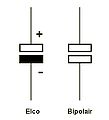|
Electronic symbol An electronic symbol is a pictogram used to represent various electrical and electronic devices or functions, such as wires, batteries, resistors, and transistors, in a schematic diagram of an electrical or electronic circuit. These symbols are largely standardized internationally today, but may vary from country to country, or engineering discipline, based on traditional conventions. Standards for symbolsThe graphic symbols used for electrical components in circuit diagrams are covered by national and international standards, in particular:
The standards do not all agree, and use of unusual (even if standardized) symbols can lead to confusion and errors.[2] Symbols usage is sometimes idiosyncratic to engineering disciplines, and national or local variations to international standards exist. For example, lighting and power symbols used as part of architectural drawings may be different from symbols for devices used in electronics. Common electronic symbolsSymbols shown are typical examples, not a complete list.[3][4] Traces GroundsThe shorthand for ground is GND. Optionally, the triangle in the middle symbol may be filled in.
Sources
ResistorsIt is very common for potentiometer and rheostat symbols to be used for many types of variable resistors and trimmers.
Capacitors
DiodesOptionally, the triangle in these symbols may be filled in, or a line may be drawn through the triangle (less desirable). The words anode and cathode aren't part of the diode symbols. For instructional purposes, sometimes two letters (A/C or A/K) are placed next to diode symbols similar to how the letters C/B/E or D/G/S are placed next to transistor symbols. "K" is often used instead of "C", because the origin of the word cathode is kathodos, and to avoid confusion with "C" for capacitors in silkscreen of printed circuit boards.
Bridge rectifiersThere are many ways to draw a single-phase bridge rectifier symbol. Some simplified symbols don't show the internal diodes.
InductorsAn inductor can be drawn either as a series of loops, or series of half-circles.
Transformers
TransistorsOptionally, transistor symbols may include a circle.[6] Note: The pin letters B/C/E and G/D/S aren't part of the transistor symbols. Bipolar
UnipolarVacuum tubes
SwitchesFor multiple pole switches, a dotted or dashed line can be included to indicate two or more switch at the same time (see DPST and DPDT examples below).
RelaysRelays symbols are a combination of an inductor symbol and switch symbol. Note: The pin letters in these symbols aren't part of the standard relay symbol.
LampsLED are located in the diode section.
Current limiters
Voltage limitersTVS and Zener diodes are located in the diode section.
Electro-acoustic devicesSpeaker symbols sometimes include an internal inductor symbol.
Antennas
Cables
ConnectorsThere are numerous connector symbol variations.
ICsLogic gatesFor the symbols below: A and B are inputs, Q is output. Note: These letters are not part of the symbols. There are variations of these logic gate symbols. Depending on the IC, the two-input gates below may have: 1) two or more inputs; 2) infrequently some have a second inverted Q output too.
The above logic symbols may have additional I/O variations too: 1) schmitt trigger inputs, 2) tri-state outputs, 3) open-collector or open-drain outputs (not shown).
Flip-flopsFor the symbols below: Q is output, Q is inverted output, E is enable input, internal triangle shape is clock input, S is Set, R is Reset (some datasheets use clear (CLR) instead of reset along the bottom). There are variations of these flip-flop symbols. Depending on the IC, a flip-flop may have: 1) one or both outputs (Q only, Q only, both Q & Q); 2) one or both forced inputs along top & bottom (R only, S only, both R & S); 3) some inputs may be inverted.
OpAmpsNote: The outside text isn't part of these symbols.
Oscillators
Miscellaneous devicesHistorical electronic symbolsThe shape of some electronic symbols have changed over time. The following historical electronic symbols can be found in old electronic books / magazines / schematics, and now considered obsolete. Capacitors (historical)All of the following are obsolete capacitor symbols.
See alsoReferences
Further reading
External linksWikimedia Commons has media related to Electrical symbols. |













![Thermistor (ANSI).[5] Use -t for NTC symbol. Use +t for PTC symbol.](http://upload.wikimedia.org/wikipedia/commons/thumb/e/e8/IEEE_315-1975_%281993%29_2.1.12.1.2.svg/120px-IEEE_315-1975_%281993%29_2.1.12.1.2.svg.png)

![General capacitor (IEC‑style); sometimes drawn with one plate curved[2]](http://upload.wikimedia.org/wikipedia/commons/thumb/7/73/IEEE_315_Fundamental_Items_Symbols_%2832%29.svg/120px-IEEE_315_Fundamental_Items_Symbols_%2832%29.svg.png)






































































































